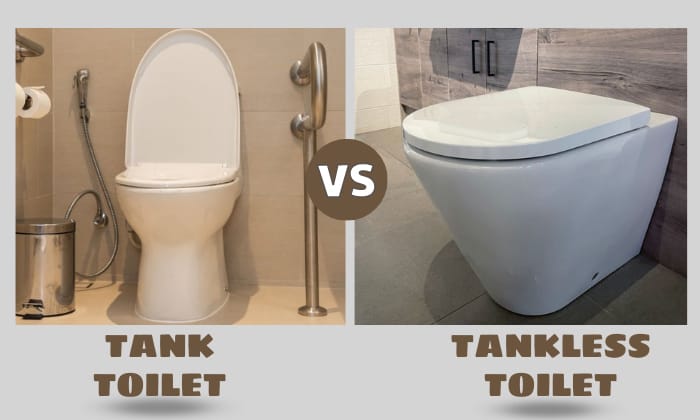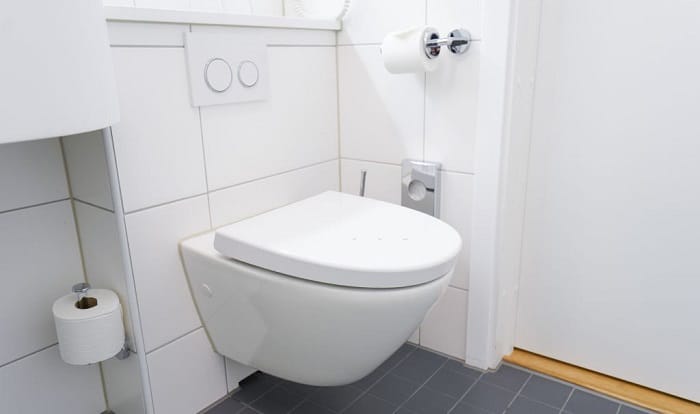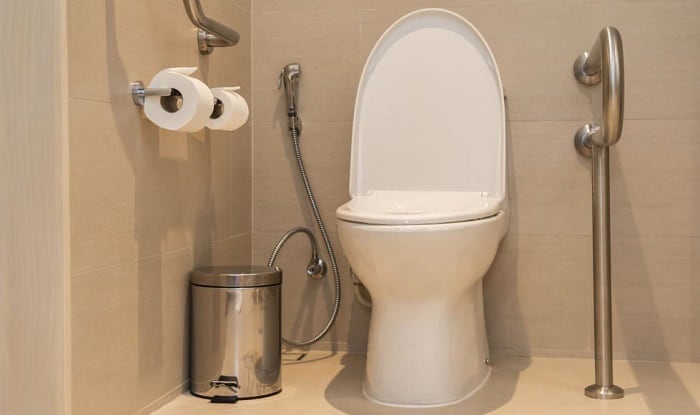The water tank that gets rid of waste from the toilet does a good job but is rather bulky. Luckily, with technology development, manufacturers have discovered how to deal with the bulkiness of the tanks. You, as a buyer, may want to know if the innovations are appropriate for residential use and if you should have tankless toilet vs tank toilet.
There’s no need to store water for a tankless toilet as it directly passes through the pipe. So the toilet appears sleek in your bathroom.
A toilet with a tank needs a siphon flushing system and a drainage system for waste disposal.
But there’s a lot more to know about these types of toilets. Continue reading to find the information.
Table of Contents
Tankless Toilet
The tankless toilet residential is admired for its sleek and modern design. How does a tankless toilet bowl work? Before you get this type of toilet, you have to be aware of its functions. The water for flushing in a tankless toilet comes directly from the pipes. In this case, the water’s high pressure is essential. Installation of a small water pump can be done for homes and buildings.
Once there’s adequate water pressure within the pipe system, you can flush the tankless toilet without any assistance from a mechanical tool. The amount of water that this toilet consumes is the same as the one with a tank.
PROS
- Space saver
The toilet with no tank won’t make your bathroom congested and clumsy. It’s also ideal for small bathrooms as it’s indeed a space saver! Wall-mounted tankless toilet like Swiss Madison Well Made Forever, Duravit Starck 3, and Fine Fixtures Vogue also great examples. Also, this kind of toilet allows you to adjust the height to ensure comfort for users.
- Less likely to have leakage issues
Since the pipes connected to a tankless toilet are under the floor, leakage is less likely to happen.
- Faster water refill
With a tankless toilet, you can flush it again right after the previous one. This is an advantage in commercial settings where there are many toilet users.
- Easy cleaning of the bowl
Due to the pumping of high pressure water when flushing a tankless toilet, the waste is discarded efficiently and the toilet bowl stays cleaner for a longer period.
- Design and aesthetics
Tankless toilets promote a sleek and modern look. If you’ve had a contemporary design in your bathroom for a long time, you can switch and upgrade to a tankless toilet.
CONS:
- Paying more money
An expert is usually necessary to ensure the proper installation of a tankless toilet. There are some complex parts that only a professional can handle.
So, you have to set a budget for installation. You should think about it wisely and not do it yourself. What if you destroy something and cause tankless toilet problems? Remember that a tankless toilet can cost a thousand dollars or more.
When you damage a tankless toilet, it means you put your thousand dollars to waste. You’ll be free from these worries if you let a professional handle the installation. But since this needs electricity, your electric bill can increase.
Another expense in choosing a tankless toilet is plumbing improvements. A good amount of water pressure is required for this toilet to flush. Most pipes in homes are not strong enough for this pressure.
If you insist it’s capable, it can damage the pipes and you have to fix the whole system. You have to settle for a better alternative: add a water pump.
- Power is needed
When the power is out, a tankless toilet can be useless as it needs electricity to operate. It will oblige you to use a bucket filled with water for flushing. Therefore, a tankless toilet is not for you if there are power outages in your area.
Tank Toilet — The Conventional Toilet
The tank of a conventional toilet can work with gravity and siphonic systems. It has a bowl and tank as the primary parts. If you look at the bowl’s side, you’ll see a U-shape section that connects it to the floor. It’s a siphon where the waste goes and the water comes up from a reservoir. A vacuum forms and with the help of gravity, the water, and the waste go downward.
Because of the siphon, a toilet can still work without a tank. But a cup of water can’t do anything about the necessary flushing. You need around two gallons of water for the gravity force to form.
This U-shaped siphon also stores gasses and keep them from filling your bathroom. When there’s air in the siphon, the flushing ceases to give way to a water refill in the tank.
To activate the tank, you need to push the handle or the button. A chain is at the tank’s bottom and attached to a rubber flapper on the tank seat. This flapper establishes a seal between the tank and water. When you push the handle or button, both the chain and flapper are pulled to let the water get into the bowl to flush the waste.
PROS:
- Various styles
Since this is the conventional toilet, it evolves for thousands of years. In the Victorian era, people realized that gravity makes flushing much better so they decided to hang the tank.
Although a modern high tank toilet exists nowadays, the former remains a choice for those who feel nostalgic about classic bathroom ambiance.
One-piece and two-piece toilets are more practical as both bowls and tanks are attached. The bowls are round or elongated. To save space, you can opt for the round bowl, but some users think the elongated bowl is more comfortable.
The government requires the bowl height to be 16 to 19 inches for everyone’s comfort, including the elderly and people with disabilities.
Also, 1.6 gallons per flush is the maximum amount of water that a toilet must use to promote water consumption. Nonetheless, there are toilets that can have lower water consumption down to 1.28 and 1.0 GPF like TOTO Drake, Kohler Wellworth, TOTO Carlyle II, and TOTO Aquia IV. You can get the one that can serve your needs at home or in a commercial building. It depends on the traffic in a certain toilet.
- Installation
Installation of tank toilets is usually a DIY project. The toilet manufacturers provide a manual so it will be easy for the users. You may not need the help of a plumber.
CONS:
- Issues and repairs
As you continue to use a tank toilet, issues and necessary repairs are inevitable. For instance, the flush handle may stop working. You may also have to replace the toilet flange. In this scenario, a two-piece toilet is not too demanding as you’ll need to buy some parts for replacement. However, you’ll need to replace a one-piece toilet that stops working in most cases.
Going Tankless or With Tank?
Aside from citing toilet differences, it’s best to compare these toilets so you’ll know which one will work for you best.
1. Maintenance and durability
A toilet with a tank requires maintenance so it can continue to serve you. Leakage is a common issue and you have to spend on repairs. Meanwhile, this is not necessary when you have a tankless toilet. Despite the low maintenance, the longevity is much better than that of a tank toilet.
2. Dimension
The dimensions of the tank toilet occupy more space than a tankless one. So, make sure that your bathroom has enough space before the installation of a tank toilet. With the tank taken off, a tankless toilet is compact so you can place it in a small bathroom. You can even save floor space when you opt for the wall-hung version.
3. Cost and expenses
You can get a tank toilet for a few hundred dollars or you can get one at $100 like the Glacier Bay toilet. But the price of a tankless will be multifold as it usually costs a thousand dollars or more.
To ensure that you don’t create a mess with this expensive toilet, it’s best to hire a professional for installation. Hence, this is another fee that you have to include in your budget.
Initially, you have to spend a lot on a tankless toilet. Then, it won’t require you to spend money in the long run given that it’s properly installed.
The case of tank toilets is the opposite. You have to pay for maintenance but as long as you take care of the toilet and use it properly, the expenses will be minimal. Although a tankless toilet will require you to pay more, it offers more advantages. It’s up to you if you’re willing to do so.
Furthermore, check this video to know more about tankless toilet vs tank toilet comparison if you needed.
Words for Final Flush!
In tankless toilets vs tank toilets, the former can offer a lot of wonderful things. However, there are downsides too, and using a tankless toilet is not advisable if you’re in an area where power outages occur.
Innovation doesn’t make a tank toilet dysfunctional, it can serve you for many years as long as you use it properly and maintain its cleanliness and good condition.

I’m Paulk Webb, and I work as a writer for Saveourwaterrebates. I’m happy to put in the time and effort to conduct market research to identify the most pressing issues faced by households concerning their plumbing. Feel free to check out our guides to get the most informed recommendations for how to solve your problems.




